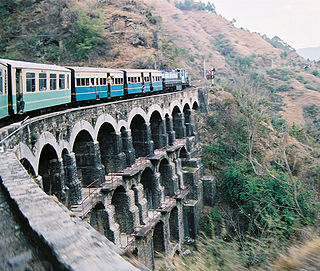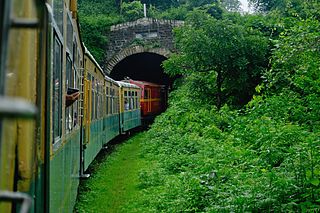Kalka–Shimla Railway
From Wikipedia, the free encyclopedia
| Mountain Railways of India | |
|---|---|
| Name as inscribed on the World Heritage List | |
| Country | India |
| Type | Cultural |
| Criteria | ii, iv |
| Reference | 944 |
| UNESCO region | Asia-Pacific |
| Inscription history | |
| Inscription | 1999 (23rd Session) |
| Extensions | 2005; 2008 |
The Kalka–Shimla Railway is a 2 ft 6 in (762 mm) narrow gauge railway in North-West India travelling along a mostly mountainous route from Kalka to Shimla. It is known for breathtaking views of the hills and surrounding villages.
Contents
[hide]History[edit]
Shimla (then spelt Simla) was settled by the British shortly after the first Anglo-Gurkha war, and is located at 7,116 feet (2,169 m) in the foothills of the Himalayas. By the 1830s, Shimla had already developed as a major base for the British.[citation needed] It became the summer capital of British India in 1864, and was also the headquarters of the British army in India. Prior to construction of the railway, communication with the outside world was via village cart.[1]
The railway was constructed on a two foot gauge (610mm) by the Delhi-Ambala-Kalka Railway Company commencing in 1898.[1] The estimated cost of Rs 86,78,500, however, the cost doubled during execution of the project.[citation needed] The 96.54 km (59.99 mi) line was opened for traffic November 9, 1903.[1] Because of the high capital and maintenance cost, coupled with peculiar working conditions, the Kalka–Shimla Railway was allowed to charge fares that were higher than the prevailing tariffs on other lines. However, even this was not good enough to sustain the company and then, the Government had to purchase it on January 1, 1906 for Rs 1,71,07,748. In 1905 the line was regauged to 2'6" gauge under guidelines from the Indian War Department seeking to ensure uniformity in all imperial narrow gauge systems.
In mid-August 2007, the government of Himachal Pradesh declared the railway a heritage property in preparation for its review in September.[2]
On this route a city named Solan is passed through, which is also known as mini Shimla. During summer season a festival celebrating a goddess (Shoolini Devi), after which the city is named, is held in June.
For about a week starting on September 11, 2007, an expert team from UNESCO was on a visit to the railway to review and inspect the railway for possible selection as a World Heritage Site. On July 8, 2008, the Kalka–Shimla Railway was included in the UNESCO World Heritage List as part of the World Heritage Site Mountain Railways of India.[3] The Mountain Railways of India (including Darjeeling Himalayan Railway and Nilgiri Mountain Railway) and Chhatrapati Shivaji Terminus in Mumbai have already been declared as world heritage properties.[4]
Route[edit]
| [hide]Kalka–Shimla Railway | |||||||||||||||||||||||||||||||||||||||||||||||||||||||||||||||||||||||||||||||||||||||||||||||||||||||||||||||||||||||||||||||
|---|---|---|---|---|---|---|---|---|---|---|---|---|---|---|---|---|---|---|---|---|---|---|---|---|---|---|---|---|---|---|---|---|---|---|---|---|---|---|---|---|---|---|---|---|---|---|---|---|---|---|---|---|---|---|---|---|---|---|---|---|---|---|---|---|---|---|---|---|---|---|---|---|---|---|---|---|---|---|---|---|---|---|---|---|---|---|---|---|---|---|---|---|---|---|---|---|---|---|---|---|---|---|---|---|---|---|---|---|---|---|---|---|---|---|---|---|---|---|---|---|---|---|---|---|---|---|---|
| |||||||||||||||||||||||||||||||||||||||||||||||||||||||||||||||||||||||||||||||||||||||||||||||||||||||||||||||||||||||||||||||
The Kalka–Shimla Railway was built to connect Shimla, the summer capital of India during the British Raj, with the Indian rail system. Now, Shimla is the capital city of Himachal Pradesh and Kalka is a town in the Panchkula district of Haryana. Spectacular scenery along the whole route, and the marvels of its construction, keeps the traveler on this line spell bound. On leaving Kalka, 656 meters (2,152 ft) above sea level, the railway enters the foothills and immediately commences its climb.
Stations[edit]
The route offers a panoramic feast of the picturesque Himalayas from the Sivalik foot hills at Kalka to several important points such as Dharampur, Solan, Kandaghat, Taradevi, Barog, Salogra, Totu (Jutogh), Summerhill and Shimla at an altitude of 2,076 meters (6,811 ft). Interestingly, all the 20 intermediate stations are located right next to bridges, built for the labour constructing the bridges to take rest there. Some of these have now been abandoned being unviable.[5]
Tunnels[edit]
Originally 107 tunnels were built on Kalka Shimla Railway Track. In 1930 they were renumbered and four of them were discarded so only 103 were left. In 2006 tunnel number 46 was dismantled so presently only 102 are in use. But tunnel number 103, the last tunnel in Shimla, is still famous as tunnel number 103 as this place has become a famous landmark of the town.
The longest tunnel is at Barog, and is associated with local tales and legends. As per a famous story of Colonel Barog, the engineer of this tunnel, had committed suicide here. He started digging the tunnel from both ends and could not align them. So he was fined 1 rupee. He could not stomach up that stigma so shot himself in the incomplete tunnel, which still exists.[6] Chief Engineer H.S. Herlington completed it after the way for constructing this was earmarked by Bhalku, a local sadhu (monk), during 1900- 1903[5][7]
Infrastructure[edit]
The line has 864 bridges, one of which is a 18.29 metre (60 ft) plate girder span and steel truss. The others are viaducts with multi-arched galleries like the ancient Roman aqueducts. Bridge No. 493, historically known as the "Arch Gallery", situated between Kandaghat and Kanoh stations, is an arch bridge in three stages, constructed with stone masonry. Bridge No. 226; between Sonwara and Dharampur is an arch gallery bridge having 5 tier galleries of multiple spans, constructed with stone masonry and bridging a deep valley surrounded by high peaks.
The railway has a ruling gradient of 1 in 33 or 3%. It has 919 curves, the sharpest being 48 degrees (a radius of 37.47 m or 122.93 feet). Climbing from 656 meters (2,152 ft), the line terminates at an elevation of 2,076 meters (6,811 ft) at Shimla. The line originally used 42 lb/yd (21 kg/m) rail but this was later relaid to 60 lb/yd (30 kg/m) rail.[1]
Locomotives[edit]
The first locomotives to arrive were two class "B" 0-4-0ST from the famous Darjeeling Himalayan Railway. These were built as 2 ft (610 mm) gauge engines, but were converted to 2 ft 6 in (762 mm) gauge in 1901. They were not large enough for the job, and were sold in 1908. They were followed by 10 engines with a 0-4-2T wheel arrangement of a slightly larger design, introduced in 1902. These locomotives weighed 21.5 tons (21.85 tonnes) each, and had 30" (762 mm) driving wheels, and 12"x16" (304.8 mm x 406.4 mm) cylinders. They were later classified into the "B" class by the North Western State Railways. All these locomotives were constructed by the British firm of Sharp, Stewart and Company.[8]
Larger locomotives were introduced in the form of a 2-6-2T, of which 30 were built with slight variations between 1904 and 1910. Built by the Hunslet and the North British Locomotive Company, these locomotives were about 35 tons (35.56 tonnes), with 30" (762 mm) drivers and 14"x16" (355.6 mm x 406.4 mm) cylinders. These locomotives, later classed K and K2 by the North Western State Railways, subsequently handled the bulk of the railways traffic during the steam era. A pair of Kitson-Meyer 2-6-2+2-6-2 articulated locomotives, classed TD, were supplied in 1928. They quickly fell into disfavour, as it often took all day for enough freight to be assembled to justify operating a goods train hauled by one of these locomotives. Shippers looking for a faster service started to turn to road transport. These 68 ton (69.09 tonnes) locomotives were soon transferred to the Kangra Valley Railway, and subsequently ended up converted to1,000 mm (3 ft 3 3⁄8 in) gauge in Pakistan.[8]
Steam operation of regular trains ended 1971.
The first diesel locomotives on the Kalka–Shimla Railway, class ZDM-1 by Arnold Jung Lokomotivfabrik (articulated with two prime movers), started operation in 1955. In the 1970s they were regauged and reclassified as NDM-1, then used on the Matheran Hill Railway.
In the 1960s, class ZDM-2 built by Maschinenbau Kiel (MaK) was introduced. These locomotives were later transferred to other lines.
Today this line is operated with class ZDM-3 diesel-hydraulic locomotives (522 kW, 50 km/h), built 1970 to 1982 by Chittaranjan Locomotive Works with a single cab road switcher body.[9] Six locomotives of the same class were built in 2008/2009 by Central Railway Loco Workshop Parel with updated components and a dual cab body providing better visibility of the track.[10]




3 comments:
Your welcome in one of the biggest jungle in Corbett National Park which is well known for dense forest and wildlife.
Nice blog , please keep updating such info got much to learn from it realy.
Also if possible kindly explain more on it.
Great post realy! Please keep posting.
Great post realy, Absolutely awsume you have mentioned every travel points such a great info realy, please do posting such always and we new travels get more such good ideas to explore.
Post a Comment